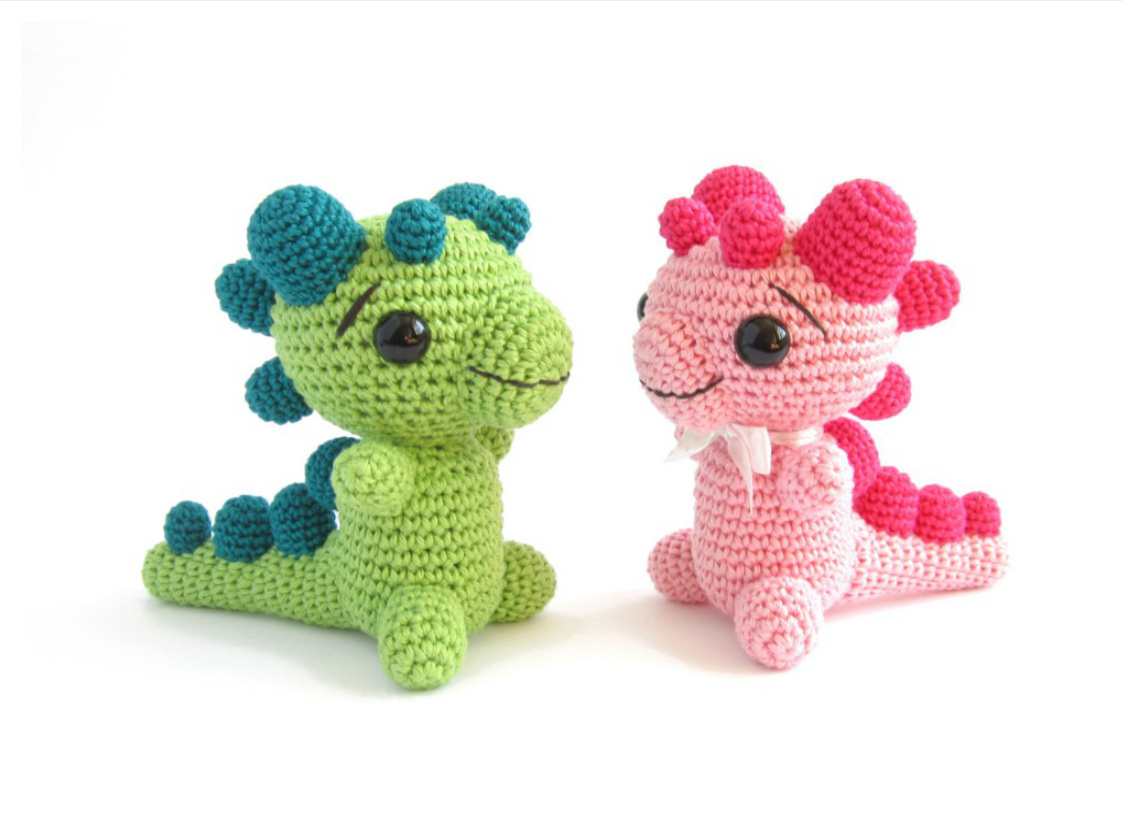
Rattle - Baby Dragon
Kristi Tullus, http://sidrun.spire.ee Size 11 cm (4 1/3") with fingering weight yarn and a 1,75 mm crochet hook.
Skills required
Crocheting in rounds, single crochet stitch, increasing and decreasing.
Difficulty
2. Beginner - suitable for novice crocheters, requires patience and precision when assembling the dragon.
Contact Info
Pattern includes unlimited support from me over email or Skype. Crochet photo tutorials and helpful tips are available on my website. kristi@spire.ee http://sidrun.spire.ee Copyright @ 2012 TU Spire. Contents of this document MAY NOT be copied, reproduced, altered, published or distributed in any way. You MAY sell finished products made with this pattern, provided you credit me (KristiTullus, http://sidrun.spire.ee) as the designer.

Tip! You can use the same pattern to make larger or smaller toys by using finer or bulkier yarn. Pick a crochet hook at least a size smaller than suggested on yarn label. Use a hook as small as possible in order to achieve a tight gauge that retains stuffing and does not allow it to show through the fabric.
Materials & Tools
·Fingering weight cotton yarn, 125m/50g (143y/50g) / 1: super fine / 4 ply / 14 wpi. You will need about 23g of yarn for the body and 7g for the spikes. 1,75 - 2,25 mm crochet hook (US thread hook size 5 - 1) or according to the yarn. · Polyester fiberfill, wool, wadding etc. for stuffing. · 9 mm (1/3") safety eyes or buttons, beads, felt etc. · Plastic egg from a Kinder Surprise chocolate egg. · Glass or plastic beads (1.5 - 3 mm). · Embroidery floss. · Yarn needle, scissors, stitch marker. · Ribbon, thread and sewing needle.
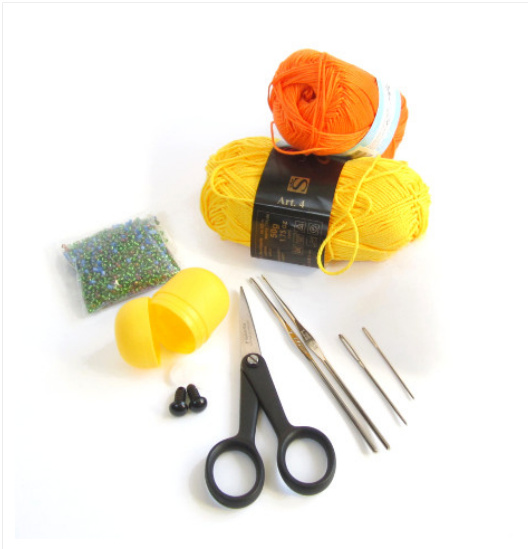
Abbreviations
Pattern is written using standard US crochet terminology. · 1: = number of the round. · mr, n = magic ring - crochet n single crochet stitches in to the adjustable loop. · sc = single crochet stitch. · sc n = make n single crochet stitches, one in each stitch. · inc = increase - make two single crochet stitches from the same stitch. · inc3 = double increase - make three single crochet stitches from the same stitch. · dec = decrease - crochet two stitches together using the invisible decrease method. · (sc 4, inc) x n = repeat the pattern between parentheses n times. · (sc 4, inc) x 6 (36) = number of stitches in a round after finishing said round.
Notes:
· Do not join at the end of each round, work in a continuous spiral. · Use a stitch marker or a piece of yarn to mark the end or the beginning of a round. Move the marker up after completing each round. · All stitches are worked in to both loops, unless stated otherwise in the pattern.
Head
1: mr, 6 (6) 2: inc x 6 (12) 3: (sc, inc) x 6 (18) 4: (inc, sc 2) x 6 (24) 5: (sc 3, inc) x 6 (30) 6: sc, inc, (sc 4, inc) x 5, sc 3 (36) 7: (sc 5, inc) x 6 (42) 8: sc 2, inc, (sc 6, inc) x 5, sc 4 (48) 9-14: sc in each stitch (48) 15: sc 2, dec, (sc 6, dec) x 5, sc 4 (42) 16: (sc 5, dec) x 6 (36) 17: sc, dec, (sc 4, dec) x 5, sc 3 (30) 18: (sc 3, dec) x 6 (24) Attach safety toy eyes between rows 13 and 14, leaving 13 stitches between them (count 12 holes). 19: (dec, sc 2) x 6 (18) 20:(sc 2, dec) x 4, sc 2 (14) Fasten off and stuff the head firmly. Leave a long yarn tail on the head for sewing.
Body
1: mr, 6 (6) 2: inc x 6 (12) 3: (sc, inc) x 6 (18) 4: (inc, sc 2) x 6 (24) 5: (sc 5, inc) x 4 (28) 6-14: sc in each stitch (28) Insert the plastic egg before you start decreasing. 15:(sc 5,dec) x 4 (24) 16: (dec, sc 2) x 6 (18) 17: (sc 2, dec) x 4, sc 2 (14) Fasten off and hide the yarn tail
Muzzle
1: mr, 6 (6) 2: inc x 6 (12) 3: sc 3, inc3 ×2,sc 4, inc3 x2, sc (20) 4-6: sc in each stitch (20) Cut the yarn, leaving a long yarn tail for sewing. Fastenoff and stuff themuzzlefirmly.
Arms
1: mr, 6 (6) 2: (sc, inc) x 6 (9) 3-5: sc in each stitch (9) Fasten off and hide the yarn tail. Stuff the arms firmly.
Legs
1: mr, 6 (6) 2: inc x 6 (12) 3-6: sc in each stitch (12) Fasten off and hide the yarn tail. Stuff the arms firmly.
Tail
1: mr, 6 (6) 2: inc, x 6 (12) 3-12: sc in each stitch (12) 13: inc, sc 11 (13) 14: sc 7, inc, sc 5 (14) 15: sc 3, inc, sc 10 (15) 16: sc in each stitch (15) 17: inc x 5, sc 10 (20) Add a bit of stuffing after every few rows to distribute it evenly.Fasten off andhide the yarn tail.
Spike 1 - make three
1: mr, 6 (6) 2: inc, sc 5 (7) 3: sc in each stitch (7)
Spike 2 - make two
1: mr,6 (6) 2: inc x 6 (12) 3: (sc 5, inc) x 2 (14) 4-7: sc in each stitch (14)
Spike 3 - make three
1: mr, 6 (6) 2: (inc x 2, sc) x 2 (10) 3-5: sc in each stitch (10)
Spike 4 - make three
1: mr, 6 (6) 2: (inc x 2, sc) x 2 (10) 3-4: sc in each stitch (10)
Spike 5 - make one
1: mr, 6 (6) 2: inc x 6 (12) 3-5: sc in each stitch (12) Make thespikes and stuff themfirmly.You caneither leave one long yarn tail on one of the spikes (spike 1) and use it sew all the spikes to thehead and body or leave shorter yarn tails on each spike.
Head
a) Attach safety toy eyes after finishing round 18.
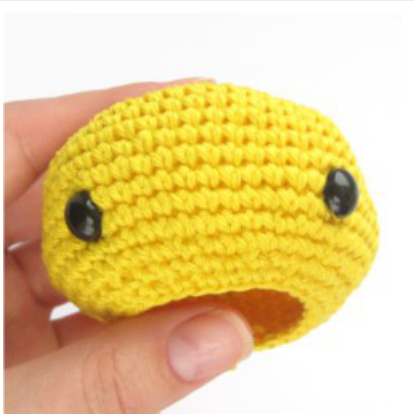
1. Place the eyes between rows 13 and 14, leaving 13 stitches (count 12 holes) between them.
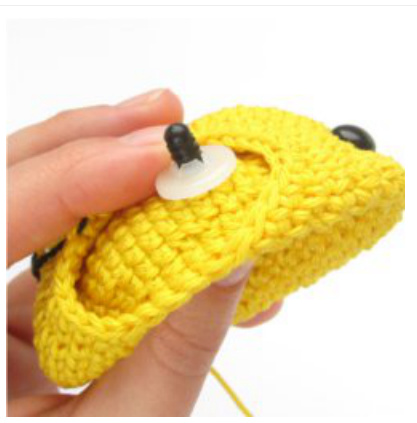
2. Make sure you are satisfied with the placement of the eyes before pushing the washer to place. Tip! If your gauge is on the looser side, put a thin layer of your stuffing material between the fabric and the washer to keep it from showing through the fabric. b) Stuff the head firmly. Start adding stuffing after finishing round 20. Tip! Stuffing is what gives your finished amigurumi the shape, so take your time. Loosen the stuffing before inserting it. Add a bit at a time until the head is firm and holds shape. c) Sew the muzzle to the head. Embroider the face with cotton embroidery floss. Tip! Use cotton embroidery floss or a yarn that will not bleed color - toys may get wet or need tobewashed.
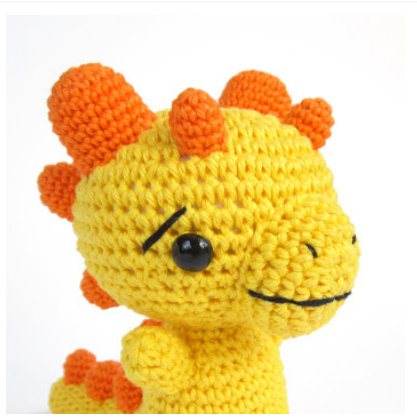
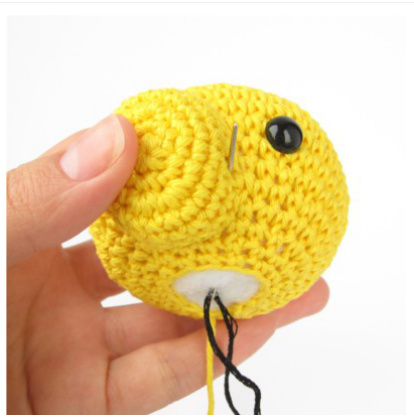
1. Insert the needle from the bottom of the head, leaving a tail of about 2 cm or an inch.
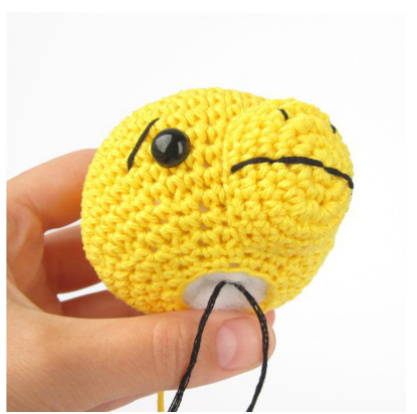
3. Come back out to the bottom. Fasten with a double knot. 2. Embroider the face.
Body
isert the plastic egg in to the body after round 14, before you start decreasing Tip! Insert the plastic egg in to the body after round 7 and make sure it is a snug fit. You may need to increase or decrease the number of increases on round 5. Make the same number of decreases on round 15. You may also need add or skip a row of single crochet stitches.
Assembling the Dragon
a) Finish all the pieces, stuff them and hide yarn tails. Tip! You can either leave one long yarn tail on the head and use it sew all the pieces to the head and body or leave shorter yarn tails on each piece and use them to sew on individual pieces. Make sure you fasten all yarn tails securely. b) Sew arms, legs and tail to the body and spikes to the head, body and tail. Tip! Sew the head to the body first. Use sewing pins to attach the pieces to the head and body before sewing to find the right placement and get a symmetrical result.
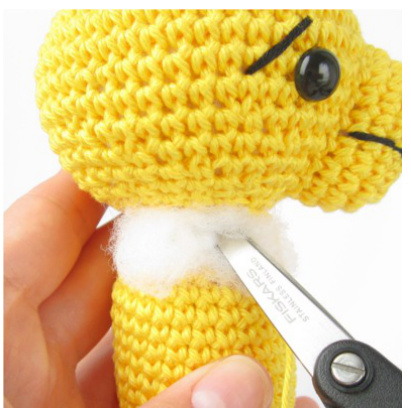
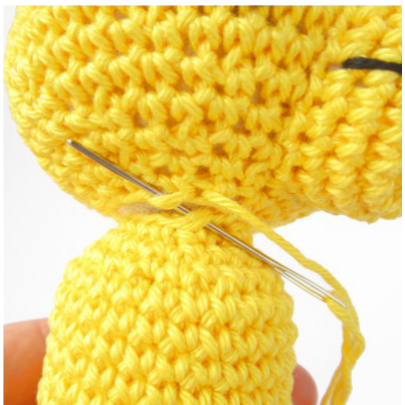
1. Sew the head to the body.
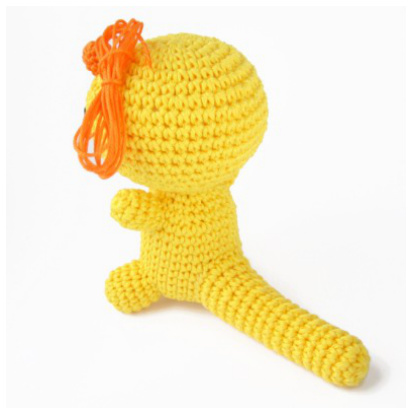
2. Add a bit more stuffing before closing the seam. 3. Use the long yarn tail to sew arms, legs and tail to the body.
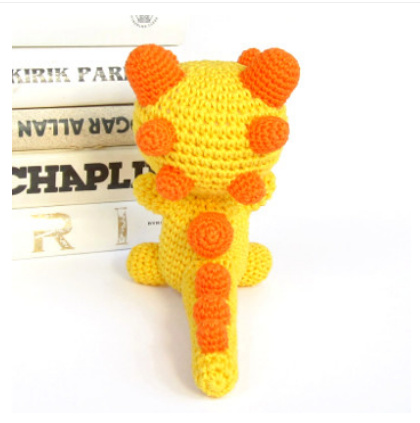
4. Sew on the spikes, starting from the nose - 1, 5, 3, 2 (in pairs), 4 (on the back), 3, 2, 1 (on the tail.)
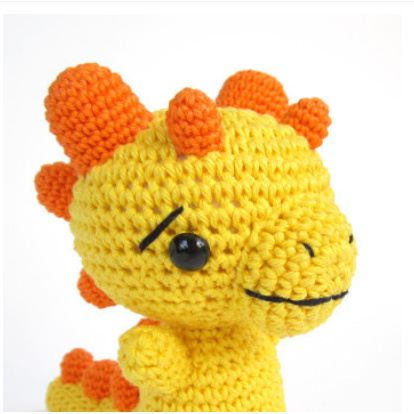
5. Add a ribbon around the neck or a bow to the head. Stitch it to place with matching thread.
Basic Amigurumi Techniaues
1. Magic Ring - Starting a piece with an adjustable loop
A magic ring is a way to begin crocheting in the round by crocheting the first round in to an adjustable loop and then pulling the loop tight. Alternatively you can chain 2, crochet n single crochet stitches in to the 2nd chain from hook.
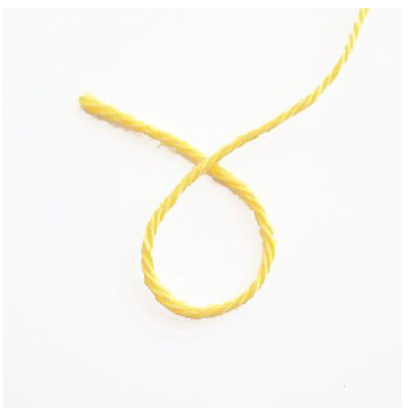
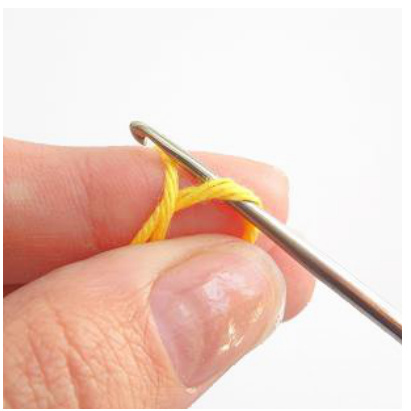
1. Make a loop an inch from the yarn end. Grab the join with your thumb and forefinger.
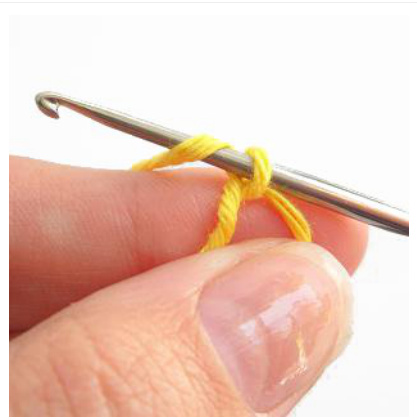
3. Yarn over and draw through the loop. 2. Insert the hook through the loop from front to back, grab the yarn and draw up a loop.
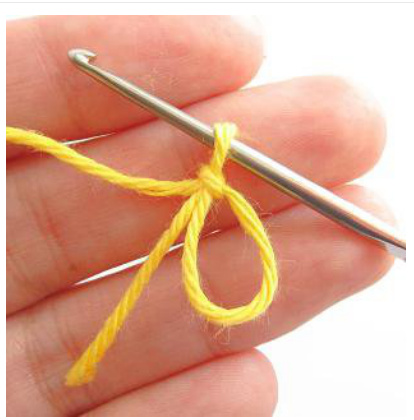
4. Pull the yarn tight. This does not count as the first single crochet stitch.
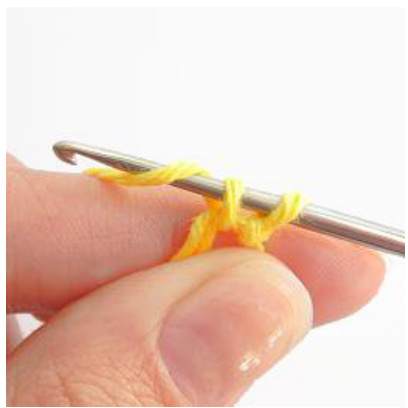
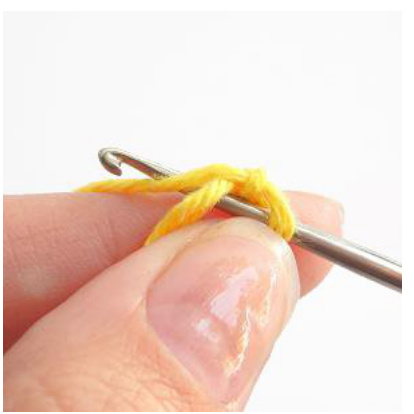
5. Start the first sc. Insert the hook through the starting loop from front to back.
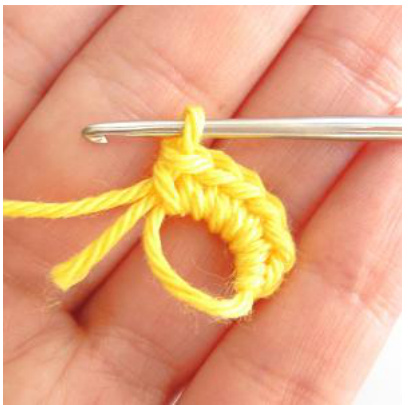
7. Continue crocheting over the loop and the yarn tail until you have the required number of sc for the first round, usually six.
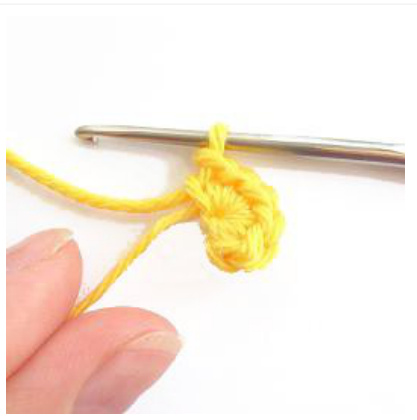
8. Grab hold of the yarn tail and pull until the center is tightly closed. http://sidrun.spire.ee
2. Finishing an open piece that will be attached to another piece
This is a way to finish an open piece that will later be sewn to another closed or open piece. If you need to leave a yarn tail for sewing, stop after step 2.
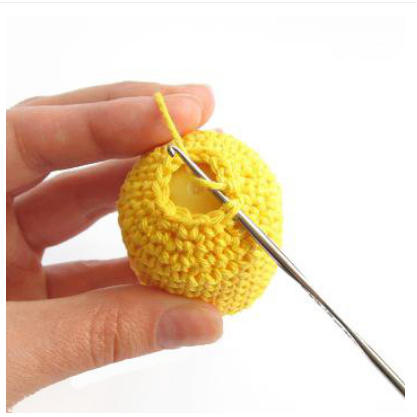
1. Make a slip stitch in the next stitch. Cut the yarn and pull the yarn tail through the loop. Insert the hook through the next stitch.
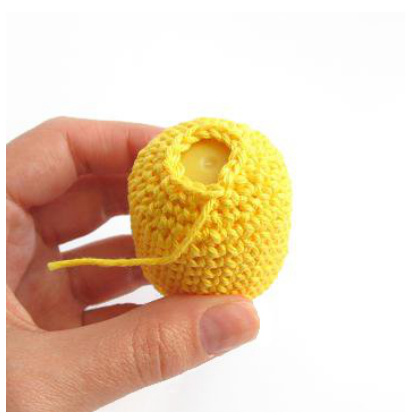
2. Grab the yarn and draw the yarn tail through the stitch from back to front.
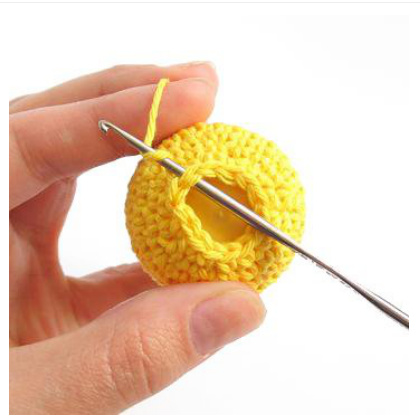
3. Insert the hook through the next stitch and draw the yarn tail through the stitch from front to back.
3. Stuffing the pieces
Stuffing is what gives your finished amigurumi the shape, so take your time. Loosen the stuffing between your hands and add a little bit at a time. Keep adding until your piece is firm and holds shape. If you start getting lumps, pull out all the stuffing, loosen it and start over. If you can see the stuffing through the fabric, you have overstuffed. Then it is best to start over and stuff more lightly.
4. Sewing an open piece to a closed piece
This is a method for sewing an open piece to a closed piece. When pieces are different color, use the yarn you used for the open piece to sew it to the closed piece.
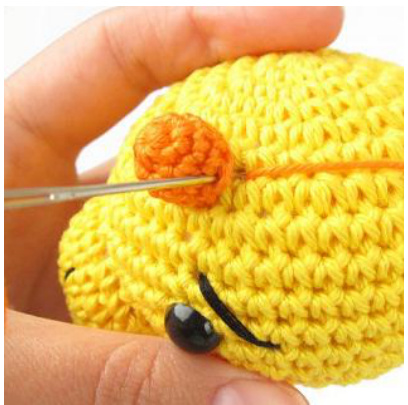
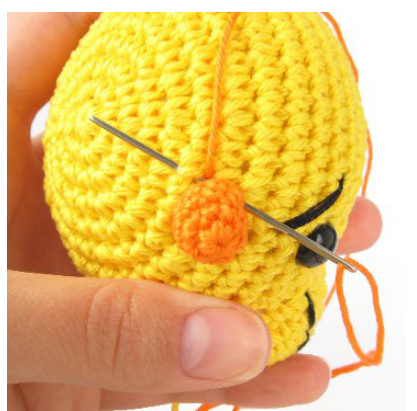
1. Bring the needle up through the fabric under a stitch of the open piece. Go down through both loops of the stitch and into the same hole. 2. Bring the needle back up directly under the next stitch. Pull the yarn tight. This makes the stitch almost invisibly small.
5. Fastening with a knot and hiding the yarn tail
This tutorial will show how to knot the yarn tail and hide it inside a piece. This method can be used when the yarn tail and the main piece are the same color.
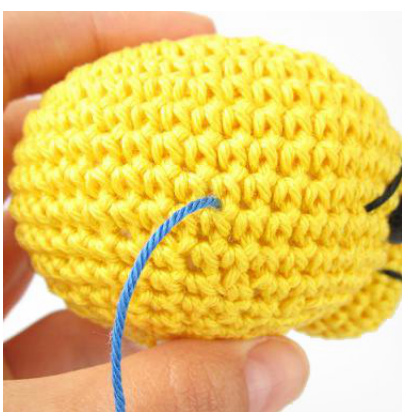
1. Bring the yarn up through the fabric after you have finished sewing.
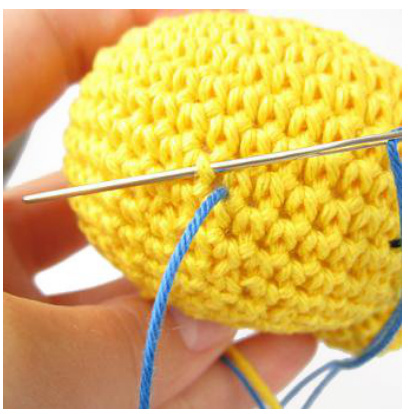
2. Insert the needle under one loop of a stitch right next to the hole.
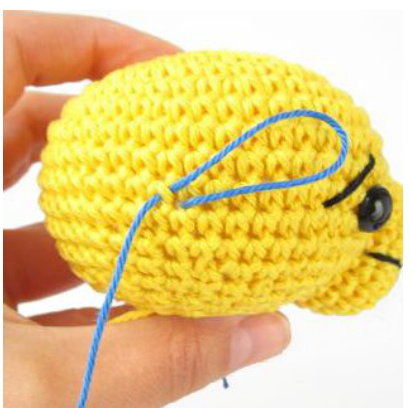
3. Pull until you have a small loop.
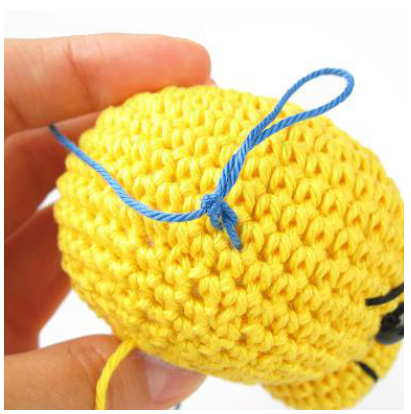
4. Make a double knot. Do not push the first knot close to the fabric.
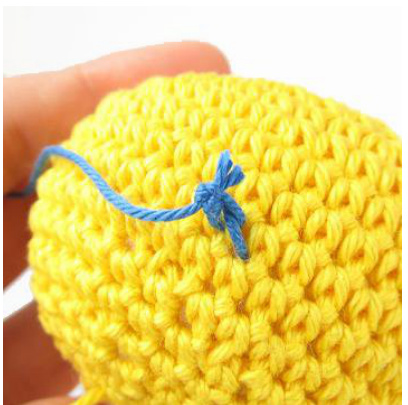
5. Cut off the loop end.
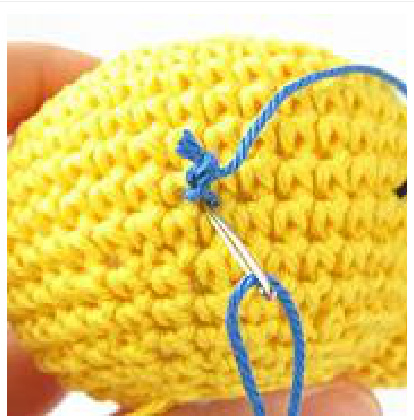
6. Insert the needle into the same hole, going up and through the piece.
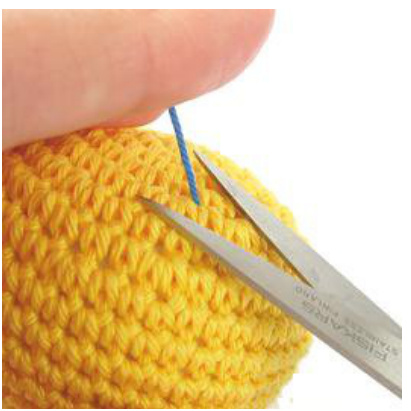
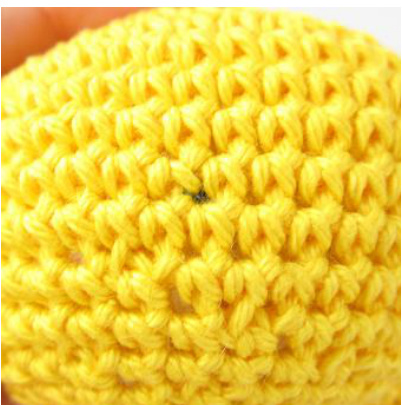
7. Pull lightly until the knot disappears into the fabric.
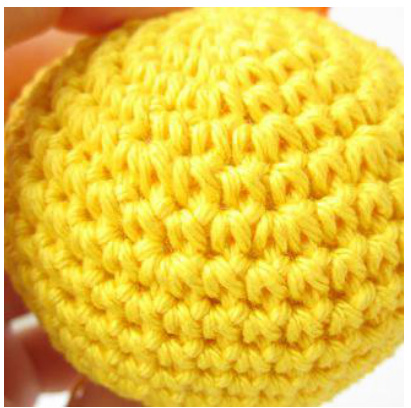
9. Yarn tail will completely disappear into the fabric 8. Pull lightly on the yarn tail and cut it off close to the fabric.









